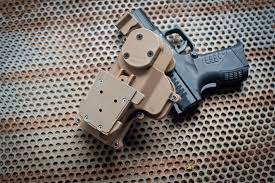
IWB vs OWB Gun Holster: Choosing the Right Carry Style
Carrying a firearm responsibly involves more than just selecting the right firearm; it extends to choosing the appropriate holster. Among the various options available, two popular styles are Inside the Waistband (IWB) and Outside the Waistband (OWB) holsters. In this guide, we’ll delve into the meaning behind IWB and OWB holsters, highlighting their differences, advantages, and disadvantages to help you make an informed decision tailored to your preferences.
IWB Holster Meaning:
IWB holsters are designed to be worn inside the waistband, securing the firearm between the body and the pants. This concealed carry style offers a discreet and inconspicuous way to carry a firearm, making it an ideal choice for those who prioritize concealment. The holster is positioned inside the trousers, typically clipped to a belt, with only a minimal portion of the firearm visible, if at all.
Pros of IWB Holsters:
- Concealment: IWB holsters excel in concealing firearms, providing a low-profile carry that doesn’t attract attention.
- Comfort: Many users find IWB holsters more comfortable as the firearm is positioned closer to the body, reducing printing and discomfort.
Cons of IWB Holsters:
- Draw Speed: Drawing from an IWB holster may be slower than an OWB holster due to the need to clear clothing and the body.
- Potential Discomfort: Some users may experience discomfort, especially in hot weather, as the firearm is against the body.
OWB Holster Meaning:
Conversely, OWB holsters are designed to be worn outside the waistband, with the firearm visibly carried on the belt. This carry style is popular among open carriers and those prioritizing quick and easy firearm access. OWB holsters come in various styles, including paddle holsters, belt slide holsters, and more.
Pros of OWB Holsters:
- Accessibility: OWB holsters offer faster and more accessible draws as the firearm is not tucked inside clothing.
- Comfort in Hot Weather: OWB holsters may be more comfortable in hot weather with the firearm outside clothing.
Cons of OWB Holsters:
- Visibility: OWB holsters may be more noticeable, potentially causing unease among those who prefer a more discreet carry.
- Printing: OWB holsters may print more, meaning the outline of the firearm is visible through clothing.
Choosing the Right Holster for You:
Ultimately, the choice between IWB and OWB holsters depends on your personal preferences, lifestyle, and the intended use of the firearm. If concealment is a top priority, an IWB holster may be preferred. On the other hand, if quick access and comfort in various weather conditions are crucial, an OWB holster might be more suitable.
Consider factors such as clothing choices, the level of concealment required, and your preferred draw speed. Additionally, training and practice are essential, regardless of the holster type chosen, to ensure a safe and effective draw.
In conclusion, understanding the meaning behind IWB and OWB holsters allows you to make an informed decision based on your needs. Whether you opt for the discreet concealment of an IWB holster or the accessibility of an OWB holster, choosing the right carry style enhances your comfort and safety.
As you decide, explore various holster options within each category, considering reputable brands, materials, and user reviews to find the perfect holster for your firearm.
Remember, responsible firearm ownership goes beyond the firearm itself—it extends to the accessories, including the holster, ensuring a safe and secure carry experience. Choose wisely, train regularly, and carry responsibly.






Leave Your Comment